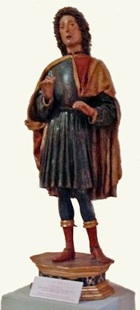

History
Filippo di Coccorano de’ Bigazzini invited the Servites to Perugia in 1255, where they settled in a number of houses near San Giacomo, outside Porta Mandorla. In 1313, they acquired some houses just inside the Etruscan walls in the parish of San Paolo, Colle Landone. Both the Dominicans and the Carmelites opposed this move, which they claimed violated the regulations that Pope Boniface VIII had instituted regarding the minimum distance between the convents of the mendicant orders. However, their objections were ignored, probably because the Servites enjoyed the support of the noble families of Colle Landone.
The Confraternita della Santissima Annunziata, which had been formed in 1334 and was associated with the Servite friars, established an oratory near what was then San Bartolomeo (later the Chiesa della SS Annunziata) in the 14th century.
About a century after their move, the church that they had built on Colle Landone proved to be inadequate, and in 1430 they began to build a much larger one that incorporated the original as its transept. The facade of the new church faced north, towards what is now Corso Vannucci, and its apse overhung the Etruscan city walls.
In 1444, Pope Eugenius IV gave the church and convent of San Fiorenzo to a group of Observant Servites from Santa Maria dei Servi, possibly because they opposed the sumptuous re-building of their original church or perhaps because part of their original convent was uninhabitable during the construction of the new church.
This new church, which became one of the most prestigious in Perugia, housed the chapels of the Baglioni family and many of the other leading families of the city. Friars from the convent also officiated at Santa Maria di Braccio, which Braccio di Malatesta Baglioni built in 1476-9.
The destruction of the church in ca. 1540 to make way for the moat of Rocca Paolina was particularly resented in Perugia. The Servites moved to Santa Maria Nuova, taking many of the works of art from the Santa Maria dei Servi with them. (The Sylvestrines at Santa Maria Nuova moved to San Fortunato).
Fragments of the convent survives:
-
✴Part of it provided accommodation for the students of Sapienza Nuova, whose original premises next to the church of Santa Maria dei Servi were also demolished. Traces of it can be seen at the junction of Via Cesare Caporali andVia Bonazzi (illustrated here, see Walk VII).
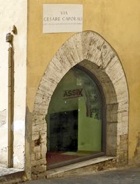
-
✴Part of it (now known as Casa Moretti-Caselli) provided accommodation for the students of Sapienza Bartolina from 1571.
(These colleges are described in the the page on the Sapienze (Colleges) of Perugia).
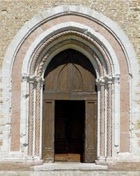
Art from Santa Maria dei Servi
Gonfalon dell' Annunziata (1466)
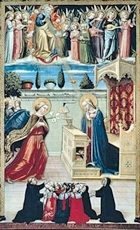
(Giovanni di Stefano, who carved the frame of the polyptych (1466) for Sant’ Angelo in his native Montelpare (see above) is also known to have carved the choir of Santa Maria dei Servi in 1466. He went on to carve the frame for the San Francesco Polyptych in Gualdo Tadino in 1470).
The central part of the banner depicts the Annunciation, set inside the palatial home of the Virgin. God the Father sits on a throne above that is formed by the wings of seraphim: He is surrounded by an angelic orchestra, and sends the Holy Spirit towards the Virgin in the form of a dove. Below, the Servites Philip Benizi and Juliana Falconieri, recommend a group of worshippers to the Virgin. (Neither had been canonised at the time that the banner was painted, and they are shown in their Servite habits with the rayonant haloes appropriate for the beatified.)
Prominent among the group of worshippers depicted are members of the Collegio dei Dottori Legisti (the lawyers’ guild), which celebrated at the Altare dell’ Annunziata on the Feast of the Annunciation and which was probably associated with the commission. The group also includes members of the penitent confraternity, at least one Servite friar and a group of pious women, most of whom wear Servite habits.
The Servites took the banner to Santa Maria Nuova when they moved there in 1540. It was first placed on the high altar there, and then moved to other locations in the church. (It was in the 19th century on the Altare dell’ Annunziata, under a lunette-shaped panel (1522) of the Pietà by Domenico Alfani - see below). It entered the Galleria Nazionale in 1863.
Adoration of the Magi (ca. 1470)
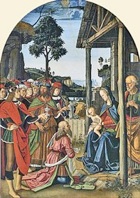
The attribution to Perugino is supported by the fact that the face of the young man on the extreme left, who wears a red cap and looks at the viewer, seems to be a self-portrait. Dating to the early 1470s is supported by the fact that the face of the king with the green cloak was re-used for St Roch in a fresco (1476 or perhaps 1478) that is dated by inscription and also attributed to Perugino, which came from San Francesco, Deruta. It therefore seems likely that this was among Perugino’s earliest important commissions in Perugia.
The Madonna and Child are depicted at the entrance to the stable with the aged St Joseph to the right. The baby Jesus blesses the oldest of the three kings, who kneels before Him, while the other two kings and their courtiers stand to the left. All of the male faces seem to be portraits, probably of members of the noble family that commissioned the work (possibly the Baglioni) and their associates. The scene is set in a rocky landscape.
Crucifix (1471)
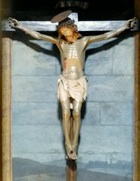
St Julian (ca. 1480)
Santi Quattro Coronati Altarpiece (1506-12)

The “Maestri Lombardi di Pietra e Legname” (the guild of Lombard stone masons and carpenters) commissioned this altarpiece from Giannicola di Paolo for the Cappella dei Lombardi in 1506. It was installed in 1512 and moved to their new chapel in Santa Maria Nuova in 1540.
-
✴The main panel depicts the Madonna and Child enthroned with the “quattro coronati” (four sculptors martyred by the Emperor Diocletian when they refused to sculpt statues of idols). Dominique-Vivant Denon, the Director of the Musée Napoleon, selected the main panel for confiscation after the Napoleonic suppression of 1810 and it remains in what is now the Musée du Louvre, Paris.
-
✴The predella panels (illustrated above), which remained in Perugia and subsequently passed to the Accademia di Belle Arti and then to the Galleria Nazionale. They depict:
-
•SS Herculanus and Constantius;
-
•three scenes from the martyrdom of the “quattro coronati” (four crowned saints); and
-
•SS Bernardino and Sebastian.
Madonna di Loreto (1507)
In 1507, Giovanni di Matteo di Giorgio Schiavone, a carpenter who had rented a workshop from the friars of Santa Maria dei Servi, left money for the endowment of a new chapel in the church that became known as the Cappella Schiavone. He also bequeathed money for an altarpiece, and the friars, who were named as his executors, almost immediately commissioned Perugino to paint it. (The artist charged an unusually low price, suggesting that he may have had a professional relationship with the deceased carpenter).
The original frame was recently discovered in the deposit of the Galleria Nazionale, confirming that the altarpiece only ever comprised this single panel. It depicts the standing Virgin and SS Jerome and Francis. It was moved to Santa Maria Nuova in 1540, when it was placed on an altar that subsequently belonged to the della Penna family. Fabrizio della Penna bought it from the friars in 1821 for his private collection, and included a copy by Giuseppe Carattoli that replaced it on the altar as part of the price. He sold the original to the National Gallery, London in 1879. The copy remains in situ in Santa Maria Nuova.
Transfiguration (1517)
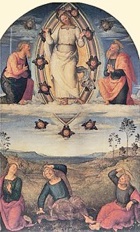
-
✴The main panel is based on the fresco (1496-1500) of the Transfiguration that Perugino had painted in the Collegio del Cambio, with the addition of a rural landscape and a mandorla of seraphim around the transfigured Christ.



-
✴Three small panels that also came from Santa Maria Nuova in 1863, which are separately exhibited in the gallery, seem to have belonged to the predella of this altarpiece. They depict:
-
•the Annunciation;
-
•the Nativity; and
-
•the Baptism of Christ.
-
It is possible that there were originally one or two others that have been lost.
Pietà (1522)
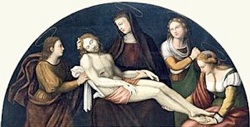
This lunette-shaped panel, which is signed by Domenico Alfani and dated by inscription, was described in the 19th century in Santa Maria Nuova, where it was displayed in the Altare dell’ Annunziata above a processional banner attributed to Nicolò di Liberatore, l’ Alunno (see above). It was almost certainly commissioned for Santa Maria dei Servi, where it would have formed part of a larger altarpiece, the other panels of which no longer survive. It probably moved to Santa Maria Nuova in 1540, and entered the Galleria Nazionale in 1863.
